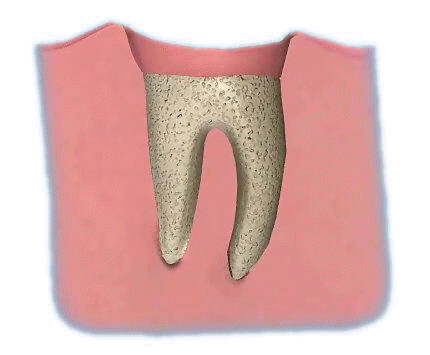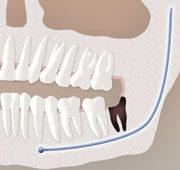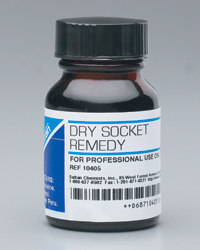 Inflammatory Disease of the Bone
Inflammatory Disease of the Bone
Inflammation is a protective tissue response to injury or destruction of tissues, which serves to destroy, dilute, or wall off both the injurious agent and the injured tissues. The classical signs of acute inflammation are pain (dolor), heat (calor), redness (rubor), swelling (tumor), and loss of function (functio laesa).
Inflammatory disease of the jaw bone can be divided into three broad overlapping categories depending largely on the extent of involvement of the jaw bone. The term alveolar osteitis is generally used to describe local inflammation of jaw bone which commonly occurs at an infected tooth socket following the removal of a tooth.
Osteomylitis is a more extensive inflammation of the bone, and it involves the bone marrow space. Periostitis means the inflammation of the outer covering of the bone.
 What is Alveolar Osteitis (Dry Socket)
What is Alveolar Osteitis (Dry Socket)
The tooth socket which the tooth was previously extracted from , fails to heal properly. This unpredictable complication in the healing of tooth extraction wounds happens to about 1 to 3 % of patients. It occurs most commonly for tooth extraction of the lower back teeth. Difficult tooth extractions like impacted wisdom tooth are also a common factor for this incident to occur. Patients who smoke are also at a higher risk compared to those who don’t.
 Why does a dry socket occur ?
Why does a dry socket occur ?
This dry socket is actually a localized inflammation of the jaw bone following either the failure of a blood clot to form in the tooth socket, or the permanent loss or disintegration of the clot.
Failure for the clot to form may be due to a relatively poor blood supply to the jaw bone caused by :
- Pagets bone disease
- after radiotherapy
- excessive use of vasoconstrictors (constrict or make the blood vessels narrower) found in the local anesthetic injection
In cases where adequate blood clot is formed, sometimes the blood clot might be washed away by excessive mouth rinsing or it may just disintegrate away prematurely due to infection by proteolytic bacteria.
After the clot is missing prematurely from the tooth socket, food, debris, saliva and bacteria collects in the empty socket causing the jaw bone to become infected and necrotic (death of bone cells) . The inflammation is localized or concentrated at the walls of the tooth socket. The dead bone is gradually separated by bone removing cells. Healing is extremely slow and follows the formation of new tissue from the surrounding un-inflamed jaw bone.
What are the symptoms of a dry socket ?
- The tooth extraction socket appears dry and the jaw bone is exposed. Therefore bone can be directly seen , there is no gum tissue covering it.
- Exposed bone is extremely painful , therefore patients might experience severe pain several days after the surgical tooth extraction .
- Dull aching, moderate to severe pain can radiate up till the patients ear.
- The patient may experience halitosis (bad breath) because the tooth socket might contain foul smelling and tasting decomposing food debris. So patients often complain of bad taste in their mouth.
How is a dry socket prevented ?
- During the surgical tooth extraction procedure, the oral surgeon should minimize the trauma to the gum tissues.
- After the surgery, the tooth socket should be irrigated with saline
- Patients should avoid smoking, drinking with a straw or spitting as the negative pressure created with those activities may dislodge the blood clot from the tooth socket.
- It is important for patient to maintain their oral hygiene of their mouth. Brushing and use of mouthwash to maintain n oral hygiene is a must. However , do not brush the dry socket area as the clot might be dislodged again, just brush at the tooth adjacent to the dry socket.
 How would the dental surgeon treat a dry socket?
How would the dental surgeon treat a dry socket?
Firstly, do not try to treat it yourself, if you feel like your sign and symptoms are similar to the above, go to your dental surgeon immediately.
These are the following treatments for dry socket :
- The tooth socket will be gently flushed with saline solution to remove any food debris there. Do not worry, the dentist will not use an instrument to scrape the tooth socket as it is not advisable.
- A medicated dressing will be given, it is called an iodoform gauze, and it will be kept inside the tooth socket.
The iodoform pack contains:
- Eugenol , to mask the pain from the bone tissue.
- Benzocaine , topical anesthetic
- Balsam of Peru, functions as a vehicle to transport the other two materials above.
Patients will usually feel relief after 5 minutes of the pack being in the tooth socket. The iodoform pack is changed everyday fr 3 to 6 days until no pain is felt. The pack would eventually have to be removed permanently as it delay the normal wound healing.
Pingback: Tweets that mention Common Inflammatory Disease of the Jaw Bone | Intelligent Dental -- Topsy.com
Wow this is a great resource.. I’m enjoying it.. good article
Hello from Vyatka River!!! Thank you for information! ItÒ‘s a good idea for next full revision…
Write more!!! :)))
Pingback: Do you suffer from orofacial dyskinesis | Intelligent Dental
Pingback: Reasons to do a gingival flap surgery | Intelligent Dental
Pingback: A continuation on gingival flap surgery | Intelligent Dental